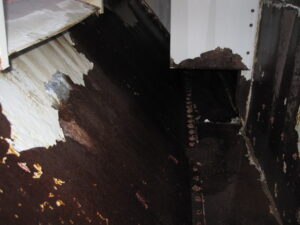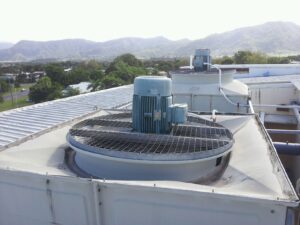Chris Willis holds court on materials of construction in packaged cooling towers
Throughout the 20th century, selecting a material of construction for your packaged cooling towers was a relatively simple process. The choices available in the market were far simpler – varying grades of galvanised or stainless steel. The choice would be made based on the lifespan of the equipment required, and the corrosiveness of the circulating water and/or surrounding environment.
Steel had been used in construction since the late 1800s, so its qualities were well known, and skills in working with the material were widespread. In addition, a clear set of standards have been in place for grades of steel since the 1930s, defining the required material composition for steel manufacturers to follow.

Chris Willis
Rigorous manufacturer and third-party testing have allowed us to understand exactly how it will react in any given set of conditions. In packaged cooling towers, three major grades of steel are typically used: Z725 galvanised steel, 304L and 316L stainless steels.
Z725 galvanised steel offers a very rugged entry-level material for cooling towers. It is usually perfect for non-aggressive circulating water and for installation in temperate climates, for non-coastal locations. The harsh environment, and usually coastal locations, mean that it is not normally recommended for the GCC region. Stainless steel grades are usually considered for projects where a longer service life is required, as well as in harsh climatic conditions, coastal environments, or for more aggressive circulating water quality. They have an increased resistance to corrosion, in particular with respect to higher chloride levels.
SS304L can handle chloride levels >60% higher than Z725 galvanised steel, which makes it far more suited to the harsh GCC region conditions, where a combination of heat, saline atmosphere and sandstorms combine to produce a highly corrosive environment. SS316L further increases this chloride resistance by 400% compared to SS304L. SS316L should be considered for any installations within five kilometres off the coast, due to the even greater salinity in the air.
Whilst the increase in cost to switch to stainless steel is usually only 1.3-1.5x compared to galvanised, the improved corrosion resistance it provides can offer a lifespan for the equipment, which is double, or even more, in the GCC region, compared to not just galvanised but any of the other materials available for packaged cooling towers. The resistance to corrosion also means less material maintenance over that lifetime; and aesthetically, it stays looking like new for far longer.

Compromised polymer coating peeling away, exposing steel to corrosion without proper galvanising protection
Steel is the strongest material used in packaged cooling towers, even at high climatic and operating water temperatures, and can achieve that strength without adding unnecessary mass to the equipment. It has no degradation due to UV exposure, meaning installation in the hot GCC region climate does not cause material damage over time.
Steel is also non-flammable, and is the only material used in packaged cooling towers that can achieve FM approval – a certification which tests and proves an equipment’s resistance to spread of fire. Steels are also fully recyclable, which make them the only materials used for packaged cooling tower structures that are fully green and sustainable.
In short, steel is the only material used in packaged cooling towers that scores positively in all of the properties important to packaged cooling tower material selection. Around the start of the 21st century, some other materials began to appear, marketed as more cost-effective ways to achieve the same benefits as stainless steel. They were fibre-reinforced polyester (FRP) and polymer-coated galvanised steel.
The benefit that is usually offered for these materials focuses on corrosion resistance, making them appear attractive in a harsh environment like in the GCC region. For a contractor or user, these seem like a compelling option; however, look deeper, and you can find they are not comparable materials.
FRP gained a strong reputation with its application in large, industrial, field-erected cooling towers, for the heavy industry and district cooling markets. These types of cooling towers use expensive and high-end FRP types, which provide a premium solution that can withstand harsh environments and offer a long service life.

However, “FRP” is a very wide-spanning term, covering many different manufacturing techniques, as well as combinations of fibres and resins. In addition, the price level from the lowest to the highest quality FRPs varies significantly. However, this is not defined by any standard grades, nor regulated, so each manufacturer can make to whatever formula and quality level they choose. The FRP being used in packaged cooling towers is a much lower price point, and with significantly reduced quality and benefits compared to the field-erected tower FRP materials.
The budget FRP types used in packaged cooling towers are of far lower strength and corrosion resistance, and are manufactured with much lower thicknesses. FRP also reduces in strength at higher temperatures, far more than in the case of steel, which results in structural deformation over time, as many customers have experienced, with basins or fan decks collapsing due to water or mechanical equipment weight.
Packaged cooling tower FRP also degrades due to exposure to UV, becoming brittle and easily damaged over time. As it’s a much-less-used material, the skillset of working with and repairing FRP is nowhere near as widespread as with steel. It’s also flammable, and in the heat of a fire loses all structural strength, causing it to collapse – there are no FRP packaged cooling towers that have achieved FM approval. Finally, it’s non-recyclable, so is not sustainable, and would need to be disposed of in landfill at the end of its life as hazardous material.
The polymer-coated steels that are now available in the market have the same structural benefits of galvanised steel, as steel is still the base material, although usually a lower grade of galvanising is hidden underneath the coating. It is marketed as equal in corrosion resistance to SS304L – which may be correct with a perfect coating application.
However, this is only true if the coating is never breached or damaged, at which point the galvanised steel is exposed. The coating stops the zinc from providing its usual sacrificial protection of the steel, and so corrosion spreads rapidly.
In a real-life application then, polymer-coated galvanised steel actually offers less protection and reduced lifespan, compared to plain Z725 galvanised steel, as has been demonstrated in third-party testing.
Polymer-coated steels cannot be FM approved, due to the flammability of the coating. They are not recyclable due to the coating, and so do not represent a sustainable material choice. And like FRP, they would need to be disposed of in landfill at the end of their lives. Similar to FRP, there are also no defined standards or grades of polymer coating, so the customer has no way to define a specification or guarantee any baseline quality level.
In summary, it is very important to understand all required properties of the materials when comparing them against one another. Marketing campaigns will often focus on only one specific attribute of that material, and which can be true only in unrealistic laboratory conditions.
The only materials used in packaged cooling towers which have a proven history of success are the three major steel grades, and these remain the optimal choice for packaged cooling tower construction in varying installed conditions. In the GCC region, stainless steel is, and always has been, the correct engineering solution.
The writer is General Manager – Middle East, Evapco Middle East DMCC. He may be contacted at christopher.willis@evapco.ae
Copyright © 2006-2025 - CPI Industry. All rights reserved.